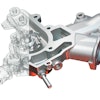The penalty for non-compliance in the food and beverage industry can be severe — just one slip-up could seriously harm consumers, brand reputation and revenue. A recent PricewaterhouseCoopers report states that hundreds of companies have recalled products over the past five years, the costs of which ranged from $10M to $30M for each recall. Mike Lorbiecki, Vice President of Sales, Process Manufacturing at IFS North America, explains how ERP systems can provide organizations the visibility required to meet stringent industry regulations and reduce the risk of costly recalls.
Food and beverage organizations are part of a highly regulated industry. Something as simple as breakfast cereal can contain upwards of 20 ingredients, requiring a number of processes and discrete manufacturing steps to produce the final product. Each step of this may consist of a critical control point where pathogens or contaminants can make their way into the product. According to the Centers for Disease Control and Prevention, 48 million illnesses in the U.S. every year can be traced back to food bacteria, viruses and parasites. Compliance and food safety is therefore a top priority.
The Three Keys for Compliance
There are three key areas each organization must adhere to in order to remain compliant in the food and beverage industry: processes and procedures, sequencing and scheduling, and employee training standards.
1. Processes and Procedures — It’s Not Alphabet Soup
In compliance terms, the first thing a manufacturer must do is set out a declaration of what it wants to achieve. This involves clearly setting out and documenting its processes and procedures to reflect industry recommendations.
This process is complicated by the “alphabet soup” of compliance certifications and regulatory bodies in the food and beverage industry, including FDA’s Good Manufacturing Processes (GMP) and Hazard Analysis and Critical Control Point (HACCP) management, Safe Quality Food (SQF) and many others. At their core, these various regulations and guidances share similar requirements, but no two are exactly the same. Just because a process meets one set of requirements doesn't mean it will meet another’s.
Traceability: Painful Paper-Based Processes
A large number of manufacturers are still using paper-based records for processes and procedures. With ingredients part of international supply chains, drilling down into the recipe to find a faulty batch of ingredients that entered the product or can take a significant amount of time. It’s generally mandated that to ensure compliance, manufacturers must keep five years’ worth of records — that's a lot of paper for even a moderate-sized facility.
In this instance, a distribution of what could be 100,000 products becomes a logistical nightmare. Due to the lack of clarity provided by paper-based process management, a much larger “safety net” has to be cast, making a recall even more widespread and expensive than necessary. An auditor will ask this to be done live, taking a large amount of time and staff to provide an answer. That delay can send up a red flag to an auditor and expose a manufacturer to additional risk.
ERP: Time, Cost and Compliance Savings
Organizations can benefit from better compliance by implementing enterprise resource planning (ERP) software that encompasses and provides visibility into the entire product lifecycle. If this ERP product also includes traceability initiatives, manufacturers can realize substantial efficiencies as lot codes are issued right from the raw material receiving process and are automatically updated by the system as soon as the material moves through each stage of the supply chain.
Manufacturers running a variety of point solutions for supply chain management and manufacturing, or those running poorly-designed ERP products, can face logistical problems when identifying the source of a contaminant or quality problem. This data visibility provided by the ERP solution gives organizations the downstream capability to identify materials at the bottom of the manufacturing process, as well as upstream traceability to view every touch point in the manufacturing and distribution process. What used to take days with paper-based documents becomes minutes with this level of traceability.
2. Sequencing and Scheduling — The Peanut Effect
The sequencing of batches is critical if manufacturers are to reduce the potential for allergen contamination. In order to reduce this risk, manufacturers need to establish the correct sequences for each batch across each machine so that types of products are grouped in order of potential contamination — from non-allergen, to milk to peanuts. However, lean scheduling efficiency also needs to be factored in. For example, two different sequences may yield the same end product, but based on the clean-out time between ingredients, the time taken to complete the sequences could differ substantially.
Incorrect machine scheduling can be dangerous, especially without the required clean-out processes — an example of this being a product that runs after a recipe including peanuts. If that product is labeled as allergen-free and the clean-out wasn’t performed properly, the potential exists to introduce peanut residue into that product.
Production and Maintenance: A Compliance Match Made in Heaven
An ERP system for food and beverage organizations should tell the production planner exactly how much time is required for a specific process, including cleaning during batch changeover and maintenance, depending on the order of the production schedule. This enables planners to define the labor pool, tools and work orders required to properly execute an equipment clean-out or schedule maintenance. Planners can accurately assess their makespan to work out how long it will take to run the processes and safely manufacture the final product.
This opens up better opportunities for food safety standards because the maintenance and workforce scheduling aligns the right engineers and staff with the right machine at the right time. Equipment remains well maintained and operated by the correct staff — saving the organization time, money and, crucially, helping them remain compliant.
3. Employee Training Standards — The Human Factor
Training and certifications are central to compliance as employee records are one of the first things an auditor will ask to see. There are a vast number of training courses in the food and beverage industry, each one having a direct effect on which jobs employees can carry out — for example, HACCP to identify and mitigate against hazards during manufacturing or FSPCA preventive controls for human and animal food.
During production, skill-based workforce scheduling is critical to putting the right person with the right skills on the right job in order to meet regulatory standards. Whole production operations can be threatened if there aren’t any employees on the factory floor with quality assurance skills. Additionally, time-sensitive jobs can be held up with staffing resource issues, potentially jeopardizing food safety. An enterprise application for food manufacturing must therefore encompass not only production and supply chain functions, but skills and training credentials too.
Scheduling for Capability, Not Just Availability
Supporting ERP solutions should, at the very least, allow organizations to keep track of employee skills and certifications as well as management training.
Solutions with resource management capabilities are able to model processing schedules based on certifications and skills prior to production. This prevents an employee from being scheduled to work on a particular job if they do not have the right qualifications. This enables manufacturers to ensure they are covered from both an availability and a training standpoint — maximizing efficiency and minimizing compliance risk.
Because of the visibility the ERP solution provides, lot codes can be traced back in a matter of minutes to show auditors that the correct staff were assigned to a job or project. With this level of visibility into staff training, there is the added value of manufacturers realizing where there may be skill shortages within the organization, providing the platform for decision-makers to invest in training programs or recruitment to fill the gap.
There’s a Solution for That
In the complex regulatory environment of the food and beverage industry, it is crucial to consider how your ERP system can work for your organization in order to ensure ongoing compliance. With no two compliance certifications or factory requirements identical, supporting systems need to provide a comprehensive and flexible tool set to allow manufacturers to mitigate risk and streamline compliance efforts.




















